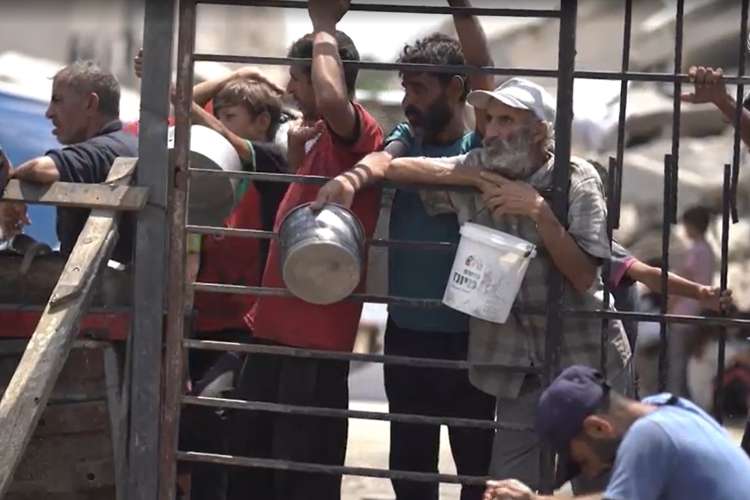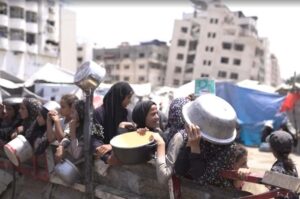
Gaza famine and options for Israel: A famine has been formally declared in Gaza City and its environs — the first IPC-confirmed famine in West Asia — and it is entirely man-made. That stark judgment, delivered 22 months into a war that began with Hamas’s attacks on October 7, 2023 and has since pulverised Gaza’s economy and public services, cannot be wished away. Two facts must be held together: Hamas triggered the war and still holds hostages; yet Israel carries legal and moral duties towards civilians under its control.
The consequences are already wider than Gaza. Israel is in a tightening strategic bind; humanitarian norms are fraying; and the ripple effects — security, economic and political — are becoming global. Unless governments move from statements to verifiable steps—ceasefire for access, a hostage deal, and an interim administration to deliver basic services—the catastrophe will widen and endure.
READ I FDI inflows to India slumps as EM funds cut exposure
A preventable famine
Begin with the mechanics of the gaza famine. The Integrated Food Security Phase Classification has found that Gaza City meets all three thresholds: extreme food deprivation in at least a fifth of households, acute malnutrition in nearly a third of children, and hunger-related mortality above the specified rate. The conclusion follows: without immediate and sustained access for food, water, health and sanitation, avoidable deaths will climb exponentially. Israel disputes the assessment; nevertheless, the plain meaning of the data is hard to escape.

Numbers at gates do not equal meals at homes. Throughput at Kerem Shalom and Zikim has been intermittent; inspection protocols have shifted; and law and order has broken down inside Gaza. The result is a delivery system that too often counts trucks rather than calories consumed. That is why a refrain recurs across aid reporting: pipelines are necessary but insufficient; access must be predictable, secure and professionally managed. Otherwise, each day’s pause is erased by the next day’s chaos.
Israel’s strategic bind
Hold another truth. Hamas bears responsibility for the attack that ignited this war and for the continued captivity of hostages. That does not license Israel to prosecute hostilities without regard to civilians. The more fighting pushes into dense neighbourhoods amid hunger, the less strategic room Israel retains. A renewed assault on Gaza City may dent Hamas’s capabilities; it will almost certainly magnify civilian harm and deepen Israel’s isolation.
The strategic question, therefore, is no longer whether Hamas can be “destroyed,” but whether military gains are eroding political ends. Every week that passes without a credible “day-after” plan—who runs policing, courts, utilities, hospitals and food systems—pushes Gaza further into ungoverned space. That vacuum corrodes Israeli security as well: famine radicalises, hostages become harder to recover, and allied patience thins. In short, tactics are outrunning strategy.
The costs of Gaza famine
The war’s externalities arrived early and linger still. Houthi attacks in the Red Sea rerouted ships around the Cape, lifted insurance premia and squeezed Suez revenues. Freight costs and delivery times rose, with a delayed but visible pass-through to prices. A Gaza famine amid renewed hostilities adds new risk: a wider Israel–Iran flare-up, a hotter northern front with Hezbollah, and further maritime disruptions in the Red Sea and Eastern Mediterranean. Energy markets will discount none of this.

Politics, too, is shifting. Public opinion in key Western capitals has turned against the conduct of the war, especially among younger voters. Arab partners juggle street anger with security ties. The thread that runs through these arenas is simple: absent an off-ramp that moves aid at scale, frees hostages, and establishes interim governance, the diplomatic coalition Israel needs to contain Iran and stabilise the region will keep fraying. The cost will be paid in security, trade and reputation.
Two norms are at risk. First, the duty to provide sustained humanitarian access during conflict. Unpredictable crossing hours, inspection queues that outstrip clearance capacity, and refusals to accept workable delivery mechanisms amount to a slow-motion breach of that duty. Second, the credibility of international law itself. Selective outrage in one theatre and paralysis in another are noticed and exploited. The net effect is a world more permissive of siege tactics, more tolerant of disinformation about civilian harm, and more dangerous for aid workers and journalists. If this is allowed to stand, others will borrow from the playbook.
What a realistic exit looks like
There is, even now, a path that puts lives first while serving Israel’s long-term security. It is not elegant. It is the least-bad sequence available—and it must be judged by outcomes, not slogans.
Ceasefire for access. Lock in a time-bound truce—60 days is feasible—tied to explicit daily tonnage targets for food, water, fuel and medical supplies. Streamline inspections; fix operating windows at crossings; monitor not trucks dispatched but meals consumed. Verification should be joint: U.N. clusters, a neutral audit cell acceptable to Israel, Egypt and key donors, and transparent public reporting. The aim is predictability; the instrument is measurement.
Hostages for prisoners, sequenced. Stage exchanges in weekly tranches, beginning with the sick, elderly and women. Link subsequent tranches to humanitarian delivery benchmarks that are independently certified. This aligns moral imperatives with operational incentives, and offers political cover in Jerusalem, Cairo and Doha.
Interim governance for essentials. Establish a service administration—U.N.-led, Arab-backed, technocratic in staffing—to run water, power, hospitals, policing and food systems under a defined security umbrella. Insulate it from both Hamas control and Israeli domestic politics. Fix an end-state: accountable Palestinian governance capable of negotiating the political future. Day-after planning is not a luxury; it is the condition for every other promise.
Open the gates—at scale and fast. When scarcity drives hoarding and diversion, volume is policy. Flood the market so prices fall and incentives to loot recede. That demands professional crowd management, designated corridors, and a communication plan—in Arabic and Hebrew—that tells communities what is coming, where, and when. Aid that is predictable is aid that is safe.
A foreign policy reset
Even-handed accountability. International investigations will be slow. Meanwhile, donors should condition funds on compliance with humanitarian access and civilian protection by all sides. The signal must be consistent: hostage-taking, indiscriminate fire and obstruction of aid are red lines regardless of flag.
Strip away the rhetoric and a sober conclusion remains. There is no military path to durable peace that sidesteps the organised delivery of food, water, medicine and security for civilians; and there is no humanitarian path that ignores the hostages or leaves Gaza’s governance to chance. The famine now confirmed in Gaza City is more than a warning; it is a pivot.
For Israel, the choice is between an unwinnable urban grind and a sequenced deal that returns the living, repatriates the dead, and trades fire for verifiable quiet. For Arab and Western partners, the obligation is to underwrite an interim administration with money, logistics and personnel—and to insist that inspection rules, access windows and delivery targets are honoured. For Palestinians, the imperative is to separate essential services from factional control and prepare, at last, for accountable governance.
Ceasefire for access; hostages for prisoners; interim governance for services. This is the narrow bridge between a man-made famine and a man-made peace. The bridge will not build itself.
